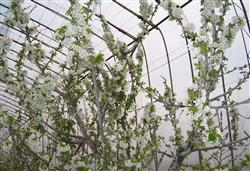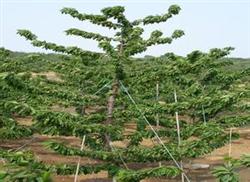Promoting Regeneration and cultivation of Cherry Tomato in greenhouse

The average yield per mu of cherry tomato cultivated by pressing soil to promote regeneration is 4653.2 kg, which is 816.9 kg higher than that of conventional cultivation, which can prolong the harvest time by more than 30 days. The main reason for increasing yield is that this cultivation method keeps the fruiting part of cherry tomato in the middle and upper part of the greenhouse, and promotes new roots by pressing soil, shortens the distance of nutrient transport, and is beneficial to the absorption of nutrients by fruit. First, variety selection of high-quality, high-yield, disease-resistant virgin, golden bead, purple jade, yellow pear, Juli and other varieties, in which saint and Juli are red, golden bead and yellow pear are yellow, purple jade is purple. The single fruit weight of each variety was 12.8 to 15.2 grams, and the fruit per panicle was 18 to 22. The virgin and purple jade are oval fruit, the golden beads are round, the yellow pear is pear-shaped, and Julie is long cylindrical. Second, the strong seedlings are cultivated by using the electric hot line to protect the roots and increase the temperature of the seedlings. The best formula of seedling substrate was mulberry sawdust ∶, wheat straw ∶, chicken manure 3 ∶ 3 ∶ 4. After crushing, sieving, mixing and stacking for 30 days, the matrix was loaded into the acupoint plate, and an electric hot line was laid under the acupoint plate. The temperature of seedling bed can be kept above 10 ℃ by using small shed plus middle greenhouse and grass canopy to keep the temperature at 25: 30 ℃ during the day, and to increase the temperature by electrifying the hot line at night. Watering at the seedling stage can be seen dry and wet, and can not be watered frequently with small water. Third, it should be planted in the middle and last ten days of February, that is, when the seedling has 7-8 leaves and buds. Covered with plastic film and kept warm 7-10 days before planting, 2000 kg of rotten chicken manure, 10 kg of urea, 80 kg of superphosphate and 40 kg of potassium sulfate were applied per mu, and the depth was 30 cm after spreading. The border was 90 cm wide and 20 cm high, and the furrow width was 30 cm. The plant spacing is 50 cm. Fourth, the hanging vine cherry tomato is pruned with a single vine, and when the plant grows to 30 cm high, the vine is hung with a plastic rope. When the lower 2-3 ears are harvested, remove the lower diseased, old and yellow leaves, drop the vine in time, and bury the old vine with soil to promote new roots and plant growth. 5. Fertilizer and water management should be controlled from planting to fruit-setting period, and the temperature should be kept at 13-25 ℃. From the fruit expansion period, the ground should be kept moist, generally laying dropper irrigation under the film at the root of the plant, each time with 200 grams of potassium dihydrogen phosphate and urea per mu of water. Sixth, spot flower greenhouse early spring cultivation, in the peak flowering period, you can use anti-falling elements such as Zaiguoling, 2mem4murD solution to spray to protect the fruit, and use cardboard to cover the back of the ear to prevent the solution from falling on the seedling vine to inhibit growth. Harvest began 60-70 days after planting. 7. Pest control mainly includes leaf miner and whitefly. Leaf miner was controlled with 20% chlorine 600 times, whitefly whitefly was controlled with 1000 times solution of imidacloprid and 1% avermectin. The main diseases are Botrytis cinerea, leaf mold and virus. On the basis of strengthening the prevention of cooling and dehumidification, Botrytis cinerea and leaf mold can be controlled by spraying 800-fold solution of Sukeling and 600-fold solution of virus A600 on the basis of eliminating aphids.
- Prev

Don't relax your management after big cherry harvest
Big cherry is basically harvested in May-June in Shaanxi, and the management is often relaxed after harvest. It is also the effective period of cherry flower bud differentiation after harvest. The balance of tree nutrition supply is timely, which plays a very important role in restoring tree potential and flower bud formation. In the main cherry producing area of Xi'an Baqiao, Tongchuan growers all have rich experience.
- Next

Causes and control methods of abnormal fruit in muskmelon
Causes and control methods of abnormal fruit in muskmelon
Related
- Moge, come on! The staff of the peasant association in the producing area of cantaloupe were frightened when the crowd gathered.
- Causes and Solutions of low Fruit setting rate of Apple
- Symptoms and control measures of passion fruit virus disease
- Fruit growing lesson: how do apple orchards keep high yields?
- Can you build orchards in the mountains? What are the pros and cons?
- How to manage the coloring period of Crisson grape?
- This paper introduces the processing technology of two kinds of fig products.
- How much is a month for retired teachers in rural areas by 2020?
- How can strawberry planting increase sugar content? We should pay attention to management in many aspects.
- What are the cultivation techniques on how to improve the yield of golden fruit?

